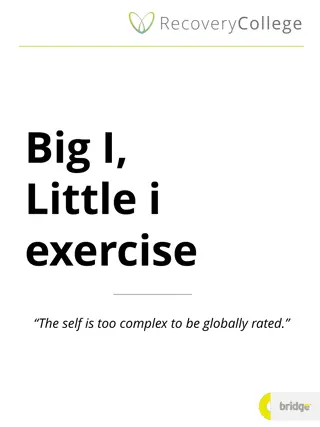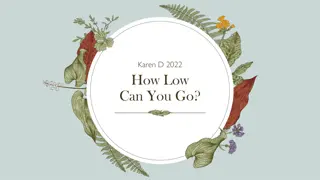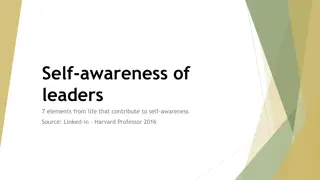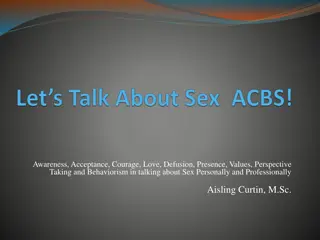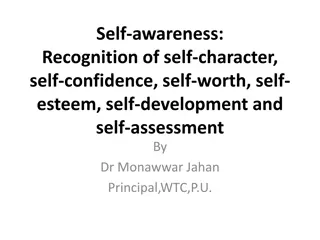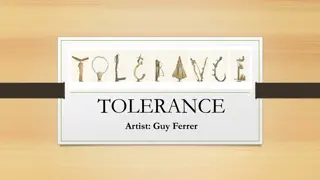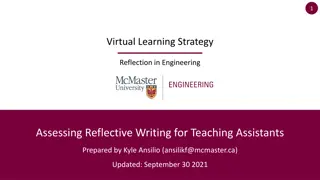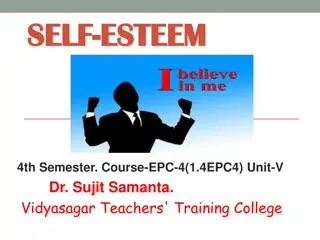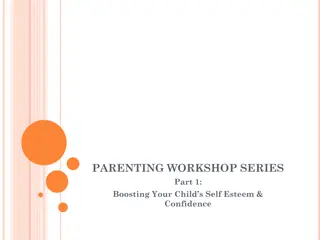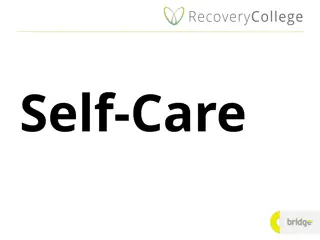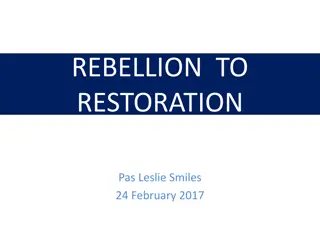The Path to Self-Acceptance and Understanding Through Artwork and Reflection
Explore the importance of self-acceptance in discovering one's true identity and the impact of emotions on our well-being. Reflect on images, artist statements, and articles to analyze universal themes and the role of adversity in self-acceptance. Engage in self-exploration through writing and discussion exercises aimed at promoting self-awareness and acceptance.
Download Presentation

Please find below an Image/Link to download the presentation.
The content on the website is provided AS IS for your information and personal use only. It may not be sold, licensed, or shared on other websites without obtaining consent from the author. Download presentation by click this link. If you encounter any issues during the download, it is possible that the publisher has removed the file from their server.
E N D
Presentation Transcript
know thyself know thyself - -a path to self acceptance a path to self acceptance
Think Think- -write write- -talk talk In your journal, respond to this prompt: Why is self acceptance an important step in knowing who you are? Free write for 5 minutes When finished, you will share with your partner.
At the end of this lesson, you will be able to At the end of this lesson, you will be able to Analyze the development of universal themes in a series of artwork, quotes, and articles that reflect the experience of diverse individuals. Describe and explain the impact of self awareness and self efficacy on our role as civic members of a community.
Emotional Baggage Emotional Baggage by: Lisa Rosenmeier, Savannah, Georgia Notice & note Using the 1stcolumn of your graphic organizer, note 2 things you see in this image. Example: I see_____. This makes me think_______. "One is not defeated until one loses hope and confidence. quote by: Falak Arif, New Delhi, India
Artist Statement Artist Statement The negative emotions that we carry around keep us from being our happiest and showing our true talents. In this piece, the bag represents all the emotions that weigh us down. Anger, Envy, Jealously, Fear, Greed, Sorrow, and many others. The Bluebird is often used as a symbol of happiness and joy. And the snow shows how if we hang onto our emotional baggage, we are left in a cold and miserable existence.
Discuss Discuss - - turn & talk turn & talk What are your thoughts on the artist s statement? To what extent do you agree/disagree? Why? Are the emotions we carry with us within our control? Could these emotions shape us? How so?
Source 2 Source 2 Now we will look at an article by Deena Prichep. Pay close attention to universal themes found in this text. Consider: How do themes that involve overcoming obstacles help us to understand the role that adversity plays in self-acceptance?
If you want to know how prison can shape a man, talk to Dan Huff. Hes spent more than half of his 59 years locked up. He says he was raised by the state of California. Even judges, when they would send me away looking back at it now they [were] kind of more like a father figure sitting up there, he says. Closer to fatherly than any father that I ever had. Those judges had plenty of reason to be concerned about him: Huff used heroin. He committed robberies. I d go to the spoon; and I d get a pistol. Or I d go to the hardware store and get a shotgun and a hacksaw and leave a piece of that barrel in the parking lot, Huff says. Huff has served time for robbery, prison escape and manslaughter. He felt comfortable behind bars. I surrounded myself with other people, and we patted each other on the back and told each other how swell we was, he says. We was the real men and everybody else is a slug or worthless or a mark. About 2 million men are currently serving time in prison or jail in America. For many of them, incarceration has played a big role in shaping their sense of what it means to be a man. And for several former inmates now living in Portland, Ore., like Huff, being on the outside has meant forming a whole new definition of manhood.
Keith Moody served a few short sentences in his youth. But when he was 30, a drug trafficking charge put him away for a decade. It definitely ... gave me a lot of time to think, he says. And I started saying, OK, I ve been proclaiming to be a father, proclaiming to be a man. But the whole time, everything I ever done was for myself. Behind bars, Moody enrolled in college classes, including sociology. It really just started opening me up, because it let me know, that s not me, he says. I m not a convict. I m not an inmate. ... I am a man. And I have the potential to be much more. The classes and the time definitely helped. But Moody says he didn t become the man he is because of prison. Nobody does. Those bars can t change you. Those guards can t change you. There has to be something in you that recognizes that change is necessary, he says. Felton Howard spent a year in prison along with Moody. Prison is not a rehabilitation center, Howard says. It s a warehouse. That s what prison is; it s a warehouse. For the past five years, he s worked at Portland s Reentry Transition Center, where he s helped thousands of former inmates. There s a lot of growing that these men have missed, he says. They find a way to fit in prison, but that doesn t mean that they ve grown as a man they re just growing older, Howard says. My formula is, if you go into prison and you re 26, and you re there for five years, you might be 27 when you get out. Prison doesn t just slow down your path forward. It can also set you back, says Emanuel Price. He was a college junior when he fell in with some old high school friends and got picked up for robbery. Going to prison was like throwing me into a lion s den, he says. I m not a lion; I m not an animal. But here I am, surrounded by lions. Prison told me to be hard, not show your emotions, walk around with a frown on your face, he adds.
That five-year sentence convinced Price to never make those mistakes again. Like Felton, he also works helping former inmates. But having to bottle up his feelings for so long, he says, made him a different man. And when I got out, I was just like, Everybody out here is soft. Why is everybody smiling? Why is everybody so happy? And then I began to unpack those things, like, Wait a minute I can smile! For Price, that transition redefining what it means to be soft, and what it means to be strong happened because of friends and family. But it can also happen in prison. And slowly, it even happened to Dan Huff. There was just times, when, reading books and stuff, there would be things in there that would bring it to my attention that I was a fraud, he says. Huff started valuing people who were compassionate and honest, and trying to be that same sort of man himself. It s hard work. Since getting out a couple of years ago, Huff has basically been figuring it all out from scratch. There ain tnothing I ve done that I had any experience of doing. It s traumatized me a time or two, he says. Just little stuff, like being laid off from work, and bills come up. I had it all mixed up. And now I see that it s tough being a square. But while dealing with hardships of daily life has been difficult especially with a criminal record it s that shift in thinking that s been the biggest change. It s devastating. On the one hand, you ve been thinking all this time that you re Superman, or God, or something. And now you find out you re not even a man. And whether it s because of prison, or in spite of it, Huff and others like him are figuring out what kind of men they want to be.
Discuss & write Discuss & write Consider how the inmates experiences shape how they viewed themselves. Describe the development of a common theme found in Emotional Baggage and I am not an inmate ... Let s fill in the 2nd column of the graphic organizer Write 2-3 sentences responding to the second prompt (above).
Before you go (on an index card) Before you go (on an index card) 3-2-1 3 statements of insight 2 wonderings 1 question for tomorrow
Day 2 Day 2 Make sure you have 1. Your graphic organizer 2. You journal sheet 3. Your article packet
Alone Alone by: Katherine Wei, 12th Grade BASIS Chandler - Chandler, Arizona Notice & note Using the 3rd column of your graphic organizer, note 2 things you see in this image. Example: I see_____. This makes me think_______. "Acceptance is the last step of grieving; let s make it the first step of living. quote by: Kate Landry, 8th Grade, Sarasota Middle School, Sarasota, Florida
Artist Statement Artist Statement My artwork symbolizes the sense of loneliness that people may often feel, especially during the pandemic. The cool color background highlights a feeling of misery and sorrow as blue and green are often associated with sadness and tears. The only warm colors in my artwork are on the girl. This contrast between warm vs. cool draws attention to the idea that anyone, even if you feel alone, emanates brightness and energy, and that everyone is valued and loved.
Discuss Discuss- -turn & talk turn & talk What are your thoughts on the artist s statement? Consider the notion of feeling out of place . Describe how this condition can refer to a physical space and also an emotional state? Do you see any similarities between this artwork and I am not an inmate ?
Source 4 Source 4 Now we will look at an excerpt from novelist James Joyce. Pay close attention to the way Joyce develops the theme of isolation. Consider: How does Joyce s framing of the main character show how he distinguishes himself from those around him?
The bell rang and then the classes began to file out of the rooms and along the corridors towards the refectory. He sat looking at the two prints of butter on his plate but could not eat the damp bread. The tablecloth was damp and limp. But he drank off the hot weak tea which the clumsy scullion, girl with a white apron, poured into his cup. He wondered whether the scullion s apron was damp too or whether all white things were cold and damp. Nasty Roche and Saurin drank cocoa that their people sent them in tins. They said they could not drink the tea; that it was hogwash. Their fathers were magistrates, the fellows said. All the boys seemed to him very strange. They had all fathers and mothers and different clothes and voices. He longed to be at home and lay his head on his mother s lap. But he could not: and so he longed for the play and study and prayers to be over and to be in bed.
He drank another cup of hot tea and Fleming said: What s up? Have you a pain or what s up with you? I don t know, Stephen said. Sick in your breadbasket, Fleming said, because your face looks white. It will go away. Oh yes, Stephen said. But he was not sick there. He thought that he was sick in his heart if you could be sick in that place. Fleming was very decent to ask him. He wanted to cry. He leaned his elbows on the table and shut and opened the flaps of his ears. Then he heard the noise of the refectory every time he opened the flaps of his ears. It made a roar like a train at night. And when he closed the flaps the roar was shut off like a train going into a tunnel. That night at Dalkey the train had roared like that and then, when it went into the tunnel, the roar stopped. He closed his eyes and the train went on, roaring and then stopping; roaring again, stopping. It was nice to hear it roar and stop and then roar out of the tunnel again and then stop.
But he was not sick there. He thought that he was sick in his heart if you could be sick in that place. Fleming was very decent to ask him. He wanted to cry. He leaned his elbows on the table and shut and opened the flaps of his ears. Then he heard the noise of the refectory every time he opened the flaps of his ears. It made a roar like a train at night. And when he closed the flaps the roar was shut off like a train going into a tunnel. That night at Dalkey the train had roared like that and then, when it went into the tunnel, the roar stopped. He closed his eyes and the train went on, roaring and then stopping; roaring again, stopping. It was nice to hear it roar and stop and then roar out of the tunnel again and then stop. Then the higher line fellows began to come down along the matting in the middle of the refectory, Paddy Rath and Jimmy Magee and the Spaniard who was allowed to smoke cigars and the little Portuguese who wore the woolly cap. And then the lower line tables and the tables of the third line. And every single fellow had a different way of walking. He sat in a corner of the playroom pretending to watch a game of dominoes and once or twice he was able to hear for an instant the little song of the gas. The prefect6 was at the door with some boys and Simon Moonan was knotting his false sleeves. He was telling them something about Tullabeg.
Then he went away from the door and Wells came over to Stephen and said: Tell us, Dedalus, do you kiss your mother before you go to bed? Stephen answered: I do. Wells turned to the other fellows and said: O, I say, here s a fellow says he kisses his mother every night before he goes to bed. The other fellows stopped their game and turned round, laughing. Stephen blushed under their eyes and said: I do not. Wells said: O, I say, here s a fellow says he doesn t kiss his mother before he goes to bed. They all laughed again. Stephen tried to laugh with them. He felt his whole body hot and confused in a moment. What was the right answer to the question? He had given two and still Wells laughed. But Wells must know the right answer for he was in third of grammar.
Discuss & write Discuss & write Consider how the main character feels isolated even when surrounded by others. What are some traits/perceptions that lead to this feeling of alienation? Let s fill in the 4th column of the graphic organizer Write 2-3 sentences in response to the question above.
Cumulative writing activity Cumulative writing activity- -Journal prompt Journal prompt Using both pieces of artwork and a text of your choice, answer the following prompt: How do the struggles individuals face encourage them to look inward? Reference specific elements within each piece of art.
Extension activity Extension activity- -A letter to me A letter to me Points of focus: 1. The letter should be written in an authentic, informal tone. 2. Prewrite-recall yourself at a specific age-then think about how you ve grown, the obstacles you ve overcome, the lessons that resonate with you, the people who ve impacted your life, etc. Example: https://www.voicesofyouth.org/blog/letter-my-younger-self


